Current Development in Accounting: Financial Reporting Analysis
VerifiedAdded on 2022/08/27
|11
|3104
|19
Report
AI Summary
This report provides a comprehensive analysis of current developments in accounting, focusing on the AASB Conceptual Framework. The report defines and evaluates 'faithful representation' and 'neutrality', key terms within the framework, and discusses their importance in financial reporting. It also explores the benefits and criticisms of conceptual frameworks, justifying their worth. Furthermore, the report critically evaluates historical cost accounting, contrasting it with alternative methods like Current Cost Accounting (CCA) and Current Purchasing Power Accounting (CPPA), and explains its influence on management and investment decisions. The report emphasizes the role of the IASB and FASB in standardizing global frameworks and highlights the evolution of accounting practices influenced by business needs and the usefulness of financial reports in decision-making.
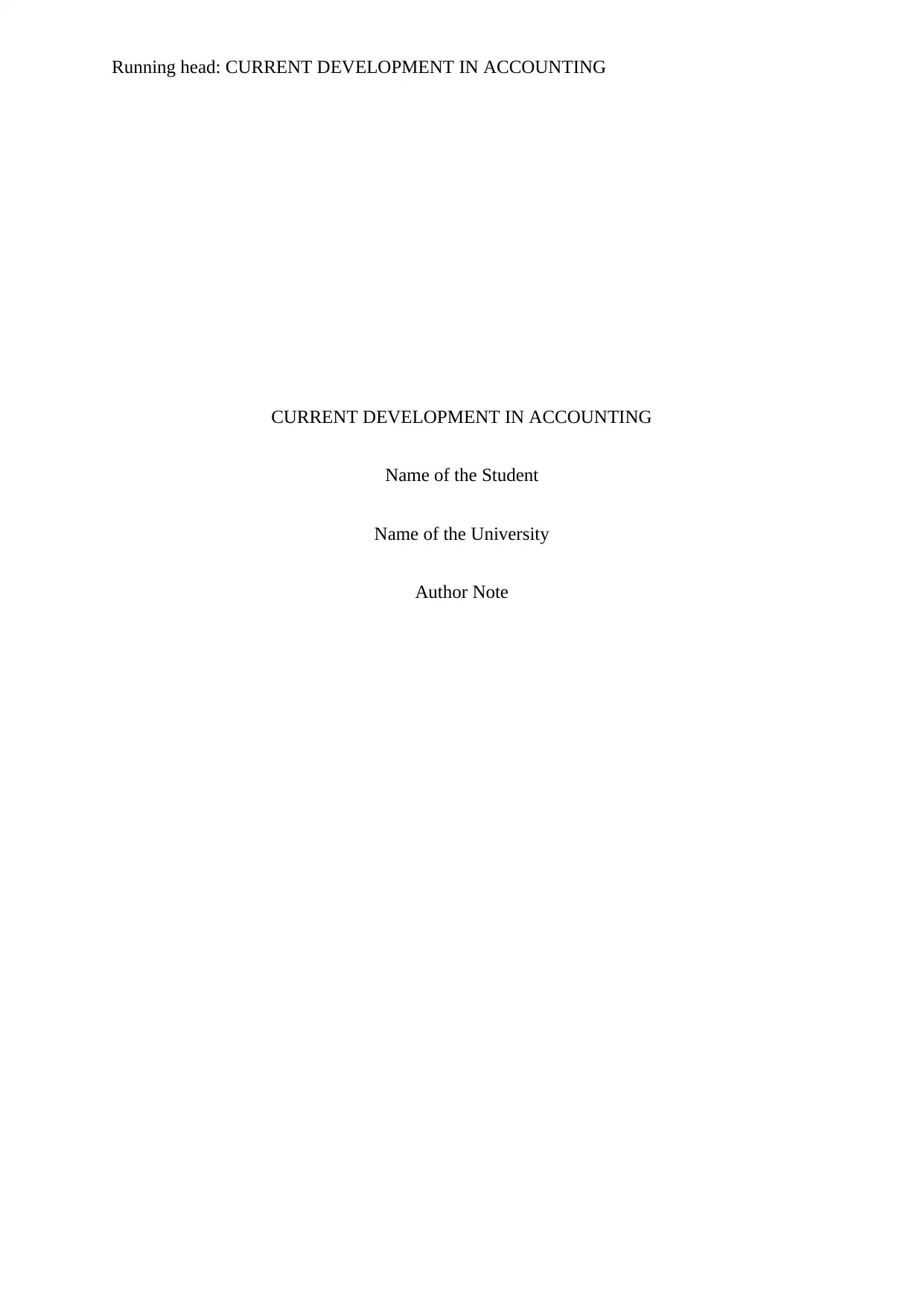
Running head: CURRENT DEVELOPMENT IN ACCOUNTING
CURRENT DEVELOPMENT IN ACCOUNTING
Name of the Student
Name of the University
Author Note
CURRENT DEVELOPMENT IN ACCOUNTING
Name of the Student
Name of the University
Author Note
Paraphrase This Document
Need a fresh take? Get an instant paraphrase of this document with our AI Paraphraser
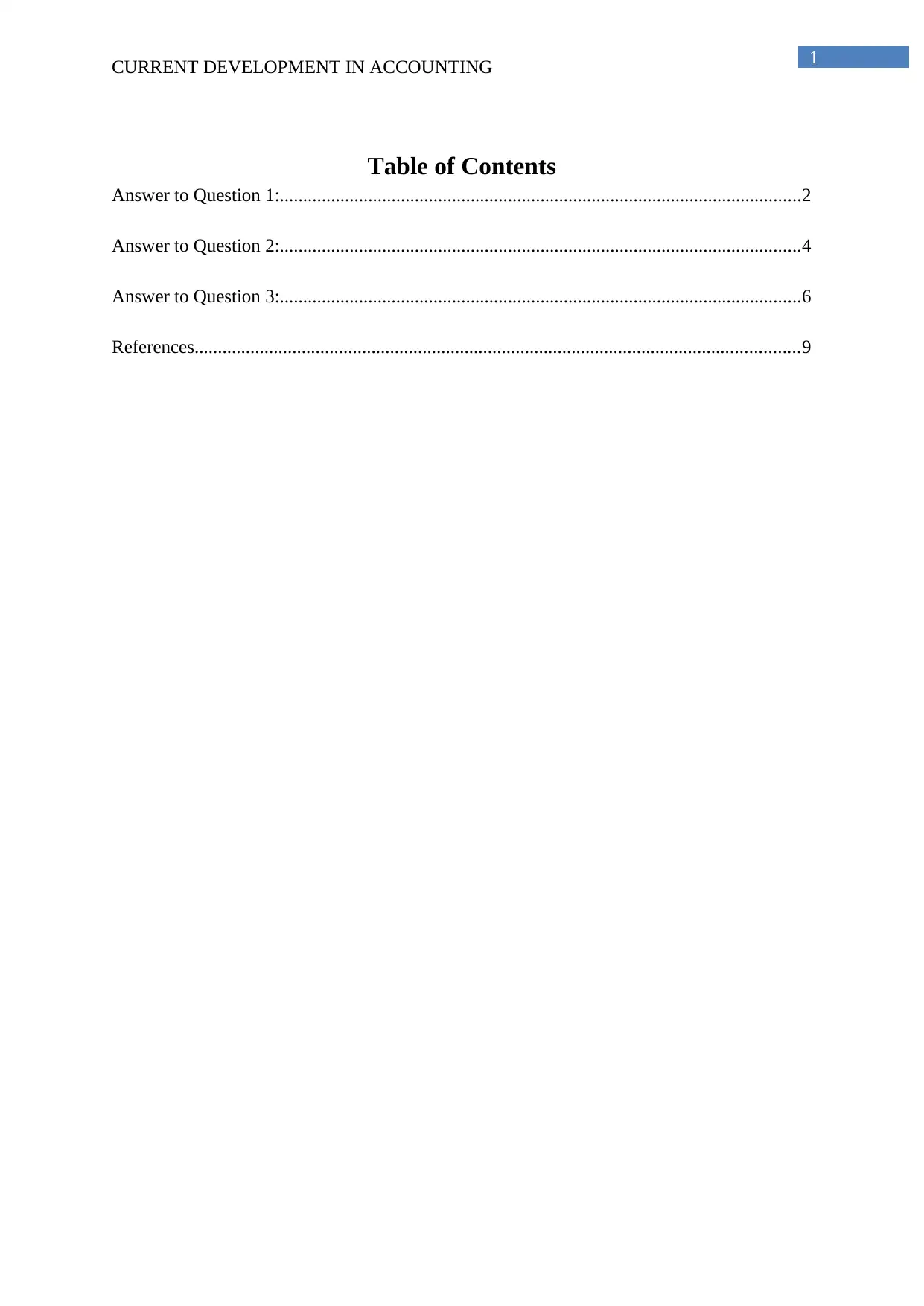
1
CURRENT DEVELOPMENT IN ACCOUNTING
Table of Contents
Answer to Question 1:................................................................................................................2
Answer to Question 2:................................................................................................................4
Answer to Question 3:................................................................................................................6
References..................................................................................................................................9
CURRENT DEVELOPMENT IN ACCOUNTING
Table of Contents
Answer to Question 1:................................................................................................................2
Answer to Question 2:................................................................................................................4
Answer to Question 3:................................................................................................................6
References..................................................................................................................................9
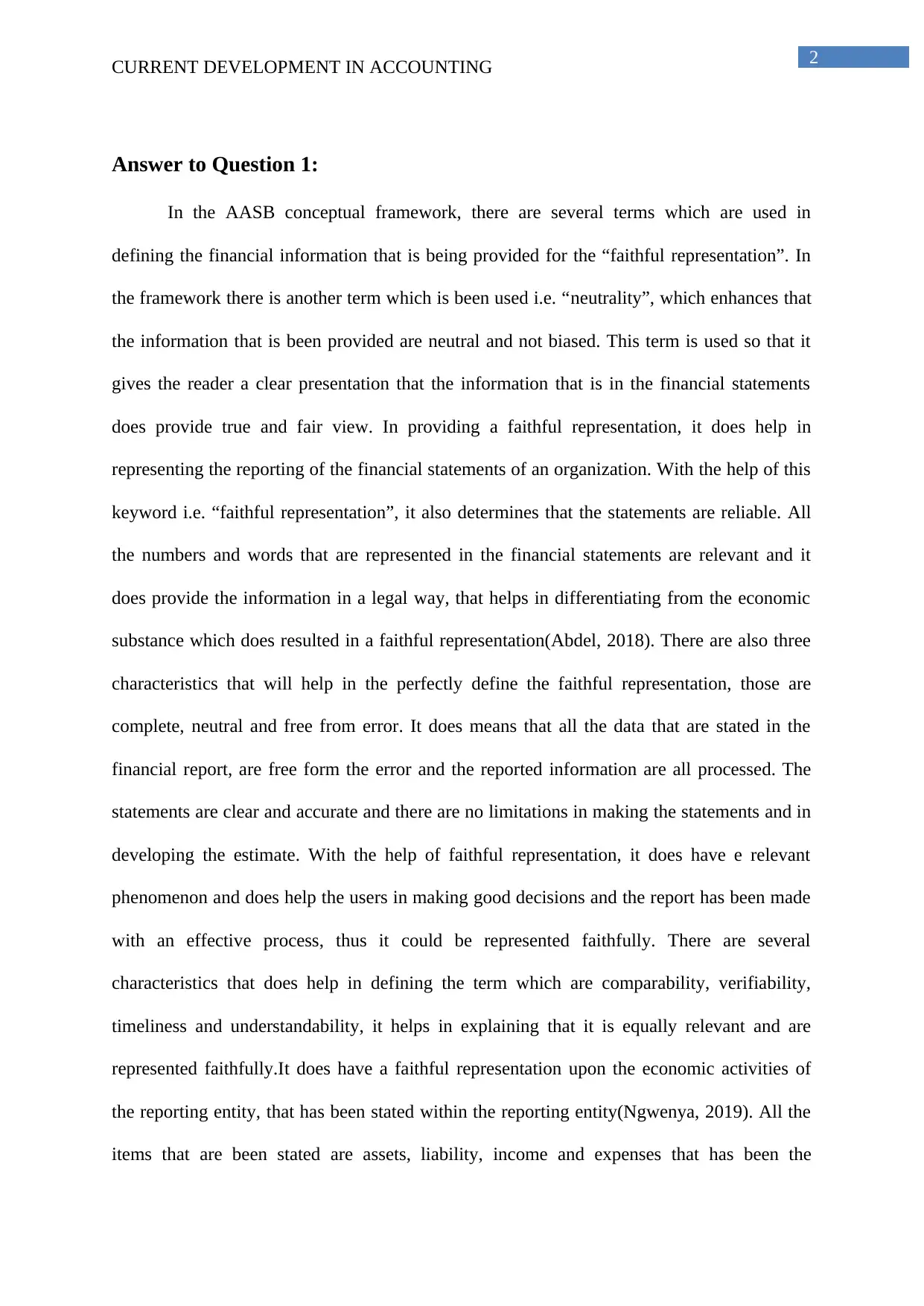
2
CURRENT DEVELOPMENT IN ACCOUNTING
Answer to Question 1:
In the AASB conceptual framework, there are several terms which are used in
defining the financial information that is being provided for the “faithful representation”. In
the framework there is another term which is been used i.e. “neutrality”, which enhances that
the information that is been provided are neutral and not biased. This term is used so that it
gives the reader a clear presentation that the information that is in the financial statements
does provide true and fair view. In providing a faithful representation, it does help in
representing the reporting of the financial statements of an organization. With the help of this
keyword i.e. “faithful representation”, it also determines that the statements are reliable. All
the numbers and words that are represented in the financial statements are relevant and it
does provide the information in a legal way, that helps in differentiating from the economic
substance which does resulted in a faithful representation(Abdel, 2018). There are also three
characteristics that will help in the perfectly define the faithful representation, those are
complete, neutral and free from error. It does means that all the data that are stated in the
financial report, are free form the error and the reported information are all processed. The
statements are clear and accurate and there are no limitations in making the statements and in
developing the estimate. With the help of faithful representation, it does have e relevant
phenomenon and does help the users in making good decisions and the report has been made
with an effective process, thus it could be represented faithfully. There are several
characteristics that does help in defining the term which are comparability, verifiability,
timeliness and understandability, it helps in explaining that it is equally relevant and are
represented faithfully.It does have a faithful representation upon the economic activities of
the reporting entity, that has been stated within the reporting entity(Ngwenya, 2019). All the
items that are been stated are assets, liability, income and expenses that has been the
CURRENT DEVELOPMENT IN ACCOUNTING
Answer to Question 1:
In the AASB conceptual framework, there are several terms which are used in
defining the financial information that is being provided for the “faithful representation”. In
the framework there is another term which is been used i.e. “neutrality”, which enhances that
the information that is been provided are neutral and not biased. This term is used so that it
gives the reader a clear presentation that the information that is in the financial statements
does provide true and fair view. In providing a faithful representation, it does help in
representing the reporting of the financial statements of an organization. With the help of this
keyword i.e. “faithful representation”, it also determines that the statements are reliable. All
the numbers and words that are represented in the financial statements are relevant and it
does provide the information in a legal way, that helps in differentiating from the economic
substance which does resulted in a faithful representation(Abdel, 2018). There are also three
characteristics that will help in the perfectly define the faithful representation, those are
complete, neutral and free from error. It does means that all the data that are stated in the
financial report, are free form the error and the reported information are all processed. The
statements are clear and accurate and there are no limitations in making the statements and in
developing the estimate. With the help of faithful representation, it does have e relevant
phenomenon and does help the users in making good decisions and the report has been made
with an effective process, thus it could be represented faithfully. There are several
characteristics that does help in defining the term which are comparability, verifiability,
timeliness and understandability, it helps in explaining that it is equally relevant and are
represented faithfully.It does have a faithful representation upon the economic activities of
the reporting entity, that has been stated within the reporting entity(Ngwenya, 2019). All the
items that are been stated are assets, liability, income and expenses that has been the
⊘ This is a preview!⊘
Do you want full access?
Subscribe today to unlock all pages.

Trusted by 1+ million students worldwide
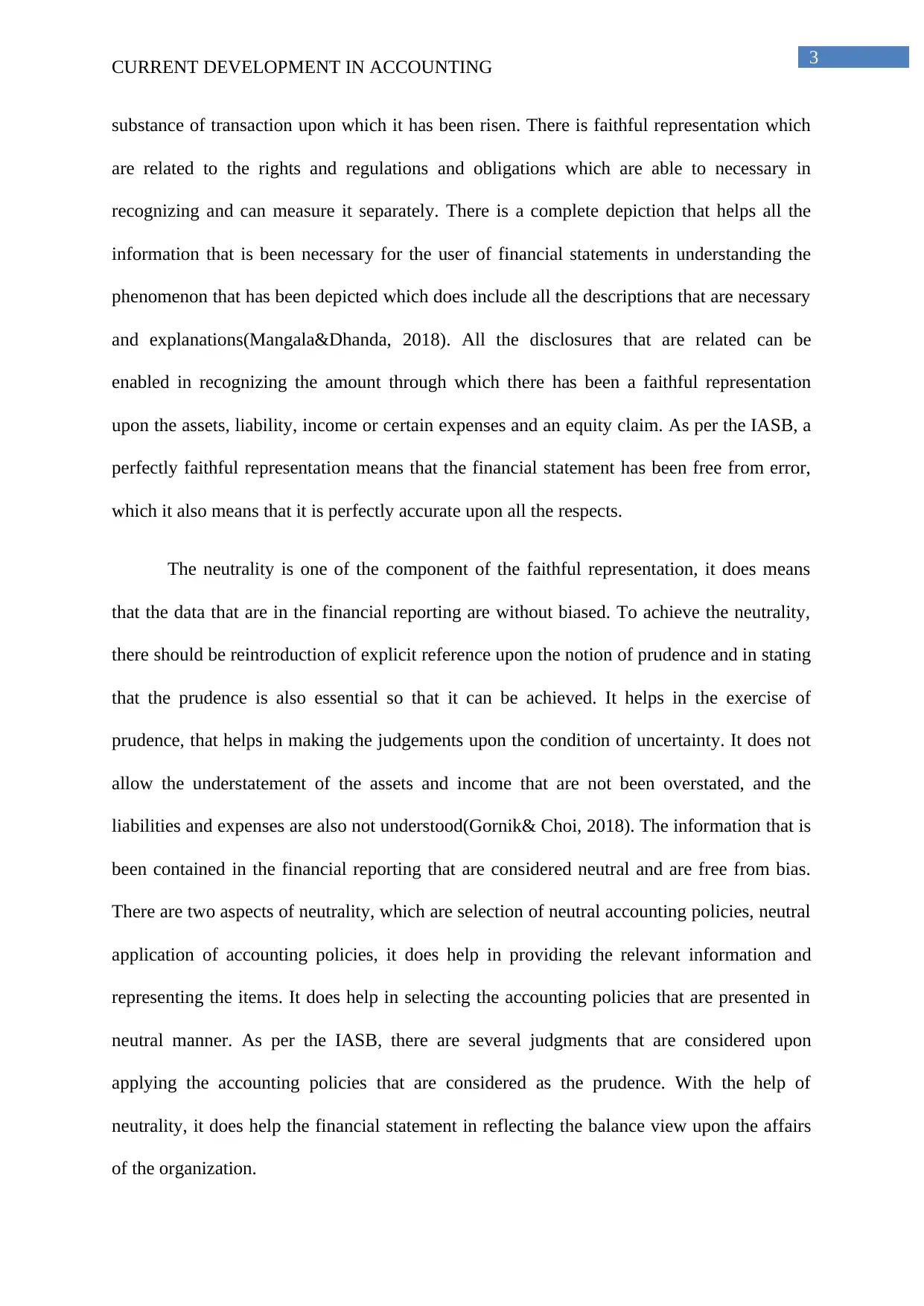
3
CURRENT DEVELOPMENT IN ACCOUNTING
substance of transaction upon which it has been risen. There is faithful representation which
are related to the rights and regulations and obligations which are able to necessary in
recognizing and can measure it separately. There is a complete depiction that helps all the
information that is been necessary for the user of financial statements in understanding the
phenomenon that has been depicted which does include all the descriptions that are necessary
and explanations(Mangala&Dhanda, 2018). All the disclosures that are related can be
enabled in recognizing the amount through which there has been a faithful representation
upon the assets, liability, income or certain expenses and an equity claim. As per the IASB, a
perfectly faithful representation means that the financial statement has been free from error,
which it also means that it is perfectly accurate upon all the respects.
The neutrality is one of the component of the faithful representation, it does means
that the data that are in the financial reporting are without biased. To achieve the neutrality,
there should be reintroduction of explicit reference upon the notion of prudence and in stating
that the prudence is also essential so that it can be achieved. It helps in the exercise of
prudence, that helps in making the judgements upon the condition of uncertainty. It does not
allow the understatement of the assets and income that are not been overstated, and the
liabilities and expenses are also not understood(Gornik& Choi, 2018). The information that is
been contained in the financial reporting that are considered neutral and are free from bias.
There are two aspects of neutrality, which are selection of neutral accounting policies, neutral
application of accounting policies, it does help in providing the relevant information and
representing the items. It does help in selecting the accounting policies that are presented in
neutral manner. As per the IASB, there are several judgments that are considered upon
applying the accounting policies that are considered as the prudence. With the help of
neutrality, it does help the financial statement in reflecting the balance view upon the affairs
of the organization.
CURRENT DEVELOPMENT IN ACCOUNTING
substance of transaction upon which it has been risen. There is faithful representation which
are related to the rights and regulations and obligations which are able to necessary in
recognizing and can measure it separately. There is a complete depiction that helps all the
information that is been necessary for the user of financial statements in understanding the
phenomenon that has been depicted which does include all the descriptions that are necessary
and explanations(Mangala&Dhanda, 2018). All the disclosures that are related can be
enabled in recognizing the amount through which there has been a faithful representation
upon the assets, liability, income or certain expenses and an equity claim. As per the IASB, a
perfectly faithful representation means that the financial statement has been free from error,
which it also means that it is perfectly accurate upon all the respects.
The neutrality is one of the component of the faithful representation, it does means
that the data that are in the financial reporting are without biased. To achieve the neutrality,
there should be reintroduction of explicit reference upon the notion of prudence and in stating
that the prudence is also essential so that it can be achieved. It helps in the exercise of
prudence, that helps in making the judgements upon the condition of uncertainty. It does not
allow the understatement of the assets and income that are not been overstated, and the
liabilities and expenses are also not understood(Gornik& Choi, 2018). The information that is
been contained in the financial reporting that are considered neutral and are free from bias.
There are two aspects of neutrality, which are selection of neutral accounting policies, neutral
application of accounting policies, it does help in providing the relevant information and
representing the items. It does help in selecting the accounting policies that are presented in
neutral manner. As per the IASB, there are several judgments that are considered upon
applying the accounting policies that are considered as the prudence. With the help of
neutrality, it does help the financial statement in reflecting the balance view upon the affairs
of the organization.
Paraphrase This Document
Need a fresh take? Get an instant paraphrase of this document with our AI Paraphraser
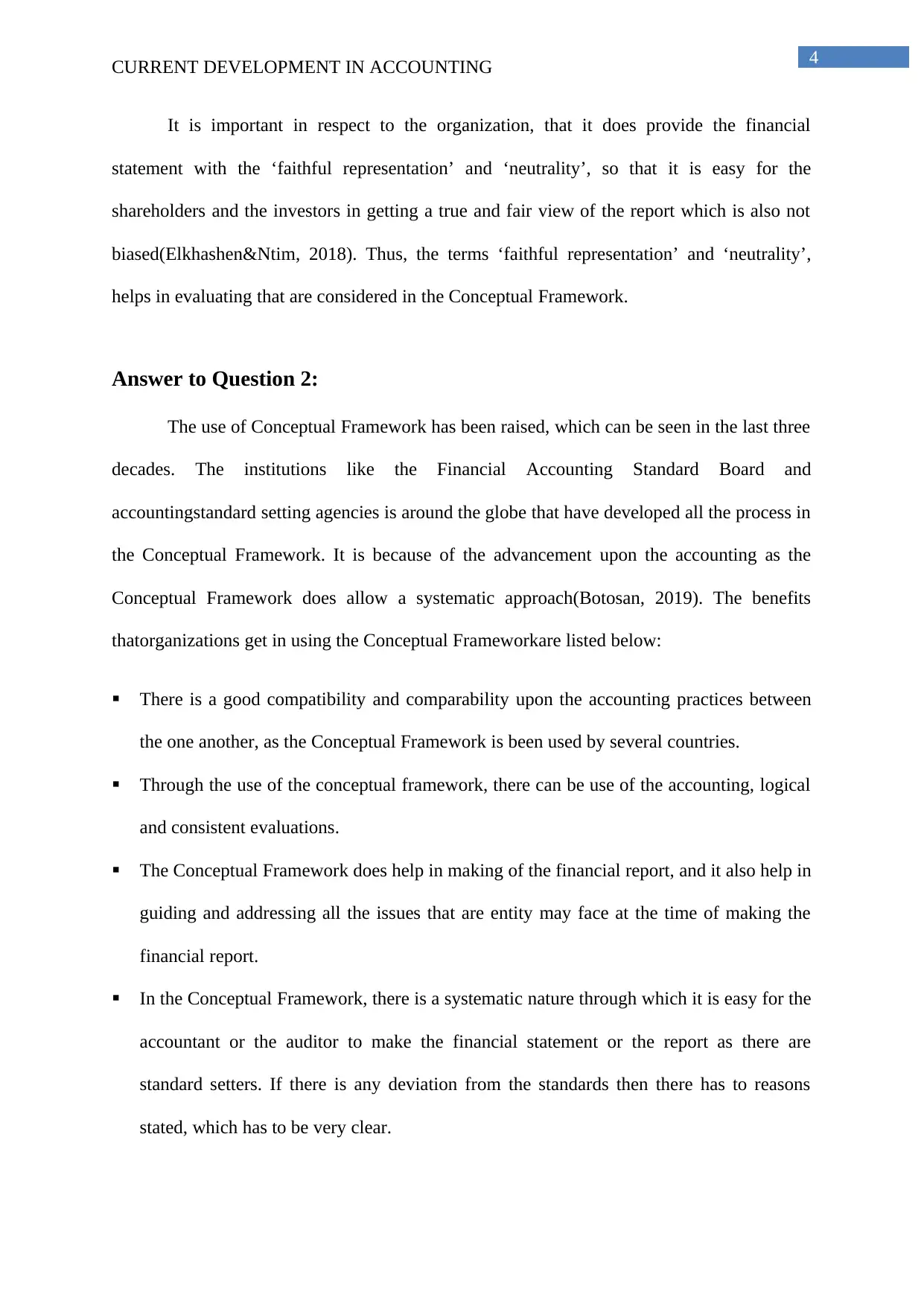
4
CURRENT DEVELOPMENT IN ACCOUNTING
It is important in respect to the organization, that it does provide the financial
statement with the ‘faithful representation’ and ‘neutrality’, so that it is easy for the
shareholders and the investors in getting a true and fair view of the report which is also not
biased(Elkhashen&Ntim, 2018). Thus, the terms ‘faithful representation’ and ‘neutrality’,
helps in evaluating that are considered in the Conceptual Framework.
Answer to Question 2:
The use of Conceptual Framework has been raised, which can be seen in the last three
decades. The institutions like the Financial Accounting Standard Board and
accountingstandard setting agencies is around the globe that have developed all the process in
the Conceptual Framework. It is because of the advancement upon the accounting as the
Conceptual Framework does allow a systematic approach(Botosan, 2019). The benefits
thatorganizations get in using the Conceptual Frameworkare listed below:
There is a good compatibility and comparability upon the accounting practices between
the one another, as the Conceptual Framework is been used by several countries.
Through the use of the conceptual framework, there can be use of the accounting, logical
and consistent evaluations.
The Conceptual Framework does help in making of the financial report, and it also help in
guiding and addressing all the issues that are entity may face at the time of making the
financial report.
In the Conceptual Framework, there is a systematic nature through which it is easy for the
accountant or the auditor to make the financial statement or the report as there are
standard setters. If there is any deviation from the standards then there has to reasons
stated, which has to be very clear.
CURRENT DEVELOPMENT IN ACCOUNTING
It is important in respect to the organization, that it does provide the financial
statement with the ‘faithful representation’ and ‘neutrality’, so that it is easy for the
shareholders and the investors in getting a true and fair view of the report which is also not
biased(Elkhashen&Ntim, 2018). Thus, the terms ‘faithful representation’ and ‘neutrality’,
helps in evaluating that are considered in the Conceptual Framework.
Answer to Question 2:
The use of Conceptual Framework has been raised, which can be seen in the last three
decades. The institutions like the Financial Accounting Standard Board and
accountingstandard setting agencies is around the globe that have developed all the process in
the Conceptual Framework. It is because of the advancement upon the accounting as the
Conceptual Framework does allow a systematic approach(Botosan, 2019). The benefits
thatorganizations get in using the Conceptual Frameworkare listed below:
There is a good compatibility and comparability upon the accounting practices between
the one another, as the Conceptual Framework is been used by several countries.
Through the use of the conceptual framework, there can be use of the accounting, logical
and consistent evaluations.
The Conceptual Framework does help in making of the financial report, and it also help in
guiding and addressing all the issues that are entity may face at the time of making the
financial report.
In the Conceptual Framework, there is a systematic nature through which it is easy for the
accountant or the auditor to make the financial statement or the report as there are
standard setters. If there is any deviation from the standards then there has to reasons
stated, which has to be very clear.
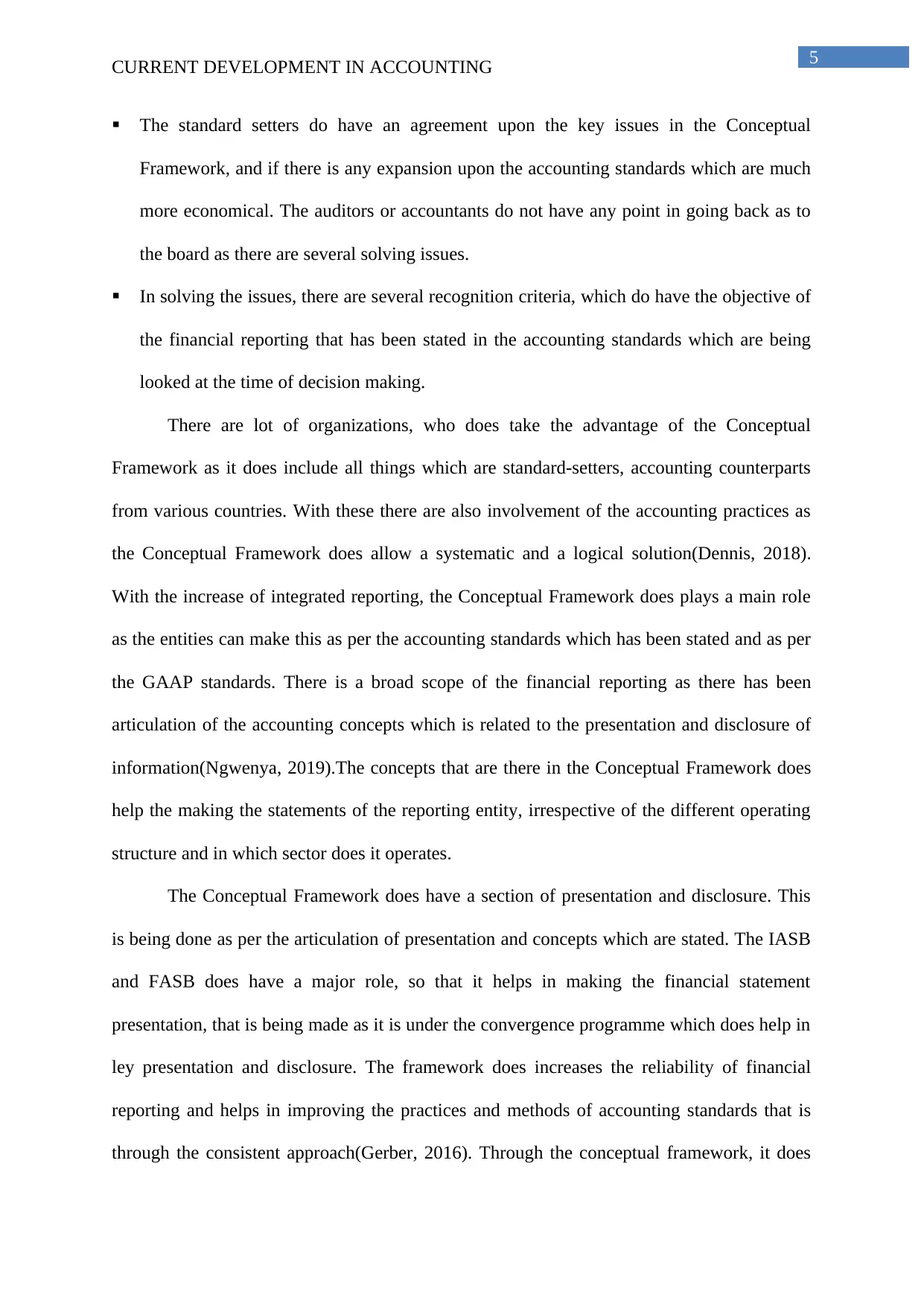
5
CURRENT DEVELOPMENT IN ACCOUNTING
The standard setters do have an agreement upon the key issues in the Conceptual
Framework, and if there is any expansion upon the accounting standards which are much
more economical. The auditors or accountants do not have any point in going back as to
the board as there are several solving issues.
In solving the issues, there are several recognition criteria, which do have the objective of
the financial reporting that has been stated in the accounting standards which are being
looked at the time of decision making.
There are lot of organizations, who does take the advantage of the Conceptual
Framework as it does include all things which are standard-setters, accounting counterparts
from various countries. With these there are also involvement of the accounting practices as
the Conceptual Framework does allow a systematic and a logical solution(Dennis, 2018).
With the increase of integrated reporting, the Conceptual Framework does plays a main role
as the entities can make this as per the accounting standards which has been stated and as per
the GAAP standards. There is a broad scope of the financial reporting as there has been
articulation of the accounting concepts which is related to the presentation and disclosure of
information(Ngwenya, 2019).The concepts that are there in the Conceptual Framework does
help the making the statements of the reporting entity, irrespective of the different operating
structure and in which sector does it operates.
The Conceptual Framework does have a section of presentation and disclosure. This
is being done as per the articulation of presentation and concepts which are stated. The IASB
and FASB does have a major role, so that it helps in making the financial statement
presentation, that is being made as it is under the convergence programme which does help in
ley presentation and disclosure. The framework does increases the reliability of financial
reporting and helps in improving the practices and methods of accounting standards that is
through the consistent approach(Gerber, 2016). Through the conceptual framework, it does
CURRENT DEVELOPMENT IN ACCOUNTING
The standard setters do have an agreement upon the key issues in the Conceptual
Framework, and if there is any expansion upon the accounting standards which are much
more economical. The auditors or accountants do not have any point in going back as to
the board as there are several solving issues.
In solving the issues, there are several recognition criteria, which do have the objective of
the financial reporting that has been stated in the accounting standards which are being
looked at the time of decision making.
There are lot of organizations, who does take the advantage of the Conceptual
Framework as it does include all things which are standard-setters, accounting counterparts
from various countries. With these there are also involvement of the accounting practices as
the Conceptual Framework does allow a systematic and a logical solution(Dennis, 2018).
With the increase of integrated reporting, the Conceptual Framework does plays a main role
as the entities can make this as per the accounting standards which has been stated and as per
the GAAP standards. There is a broad scope of the financial reporting as there has been
articulation of the accounting concepts which is related to the presentation and disclosure of
information(Ngwenya, 2019).The concepts that are there in the Conceptual Framework does
help the making the statements of the reporting entity, irrespective of the different operating
structure and in which sector does it operates.
The Conceptual Framework does have a section of presentation and disclosure. This
is being done as per the articulation of presentation and concepts which are stated. The IASB
and FASB does have a major role, so that it helps in making the financial statement
presentation, that is being made as it is under the convergence programme which does help in
ley presentation and disclosure. The framework does increases the reliability of financial
reporting and helps in improving the practices and methods of accounting standards that is
through the consistent approach(Gerber, 2016). Through the conceptual framework, it does
⊘ This is a preview!⊘
Do you want full access?
Subscribe today to unlock all pages.

Trusted by 1+ million students worldwide
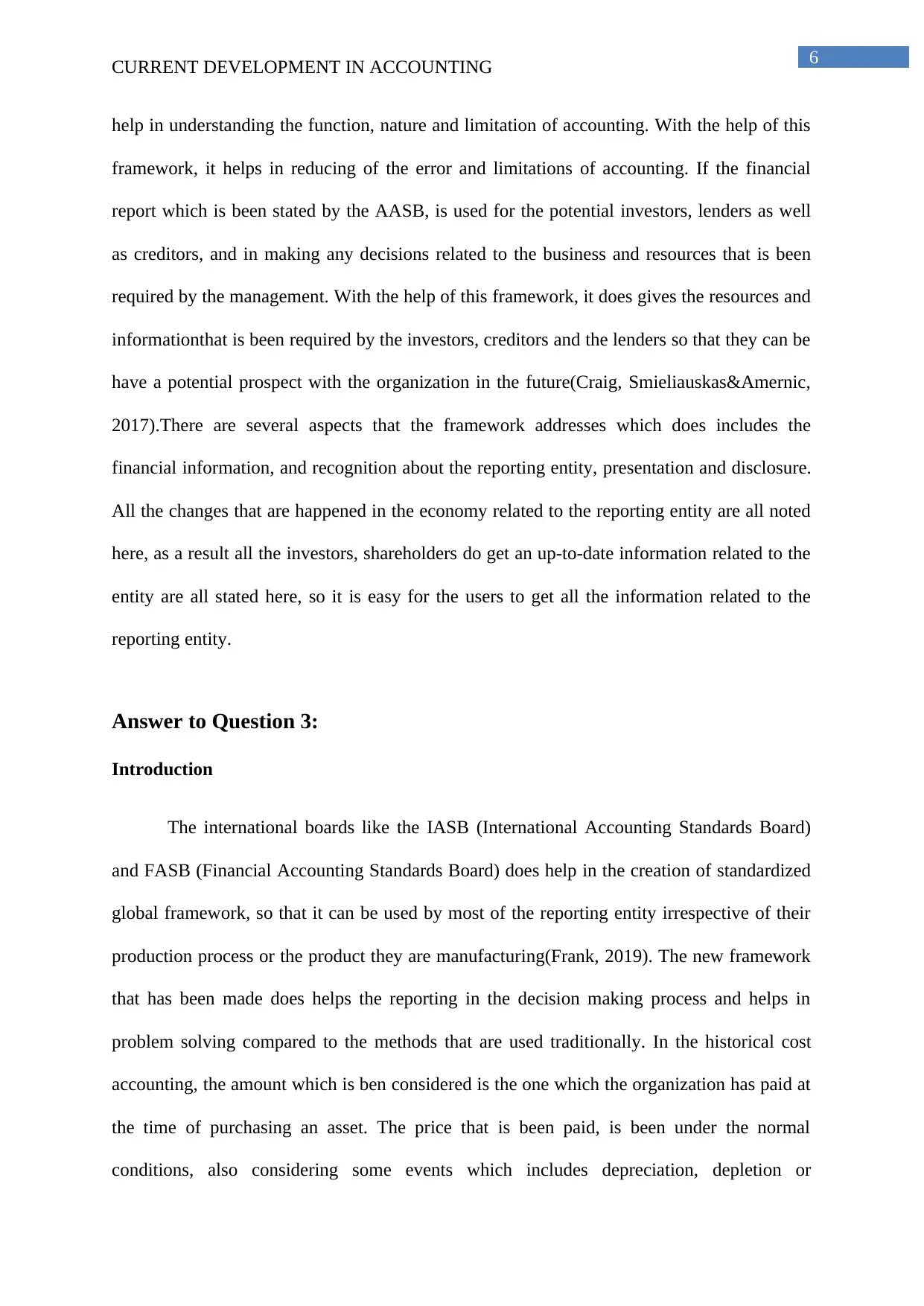
6
CURRENT DEVELOPMENT IN ACCOUNTING
help in understanding the function, nature and limitation of accounting. With the help of this
framework, it helps in reducing of the error and limitations of accounting. If the financial
report which is been stated by the AASB, is used for the potential investors, lenders as well
as creditors, and in making any decisions related to the business and resources that is been
required by the management. With the help of this framework, it does gives the resources and
informationthat is been required by the investors, creditors and the lenders so that they can be
have a potential prospect with the organization in the future(Craig, Smieliauskas&Amernic,
2017).There are several aspects that the framework addresses which does includes the
financial information, and recognition about the reporting entity, presentation and disclosure.
All the changes that are happened in the economy related to the reporting entity are all noted
here, as a result all the investors, shareholders do get an up-to-date information related to the
entity are all stated here, so it is easy for the users to get all the information related to the
reporting entity.
Answer to Question 3:
Introduction
The international boards like the IASB (International Accounting Standards Board)
and FASB (Financial Accounting Standards Board) does help in the creation of standardized
global framework, so that it can be used by most of the reporting entity irrespective of their
production process or the product they are manufacturing(Frank, 2019). The new framework
that has been made does helps the reporting in the decision making process and helps in
problem solving compared to the methods that are used traditionally. In the historical cost
accounting, the amount which is ben considered is the one which the organization has paid at
the time of purchasing an asset. The price that is been paid, is been under the normal
conditions, also considering some events which includes depreciation, depletion or
CURRENT DEVELOPMENT IN ACCOUNTING
help in understanding the function, nature and limitation of accounting. With the help of this
framework, it helps in reducing of the error and limitations of accounting. If the financial
report which is been stated by the AASB, is used for the potential investors, lenders as well
as creditors, and in making any decisions related to the business and resources that is been
required by the management. With the help of this framework, it does gives the resources and
informationthat is been required by the investors, creditors and the lenders so that they can be
have a potential prospect with the organization in the future(Craig, Smieliauskas&Amernic,
2017).There are several aspects that the framework addresses which does includes the
financial information, and recognition about the reporting entity, presentation and disclosure.
All the changes that are happened in the economy related to the reporting entity are all noted
here, as a result all the investors, shareholders do get an up-to-date information related to the
entity are all stated here, so it is easy for the users to get all the information related to the
reporting entity.
Answer to Question 3:
Introduction
The international boards like the IASB (International Accounting Standards Board)
and FASB (Financial Accounting Standards Board) does help in the creation of standardized
global framework, so that it can be used by most of the reporting entity irrespective of their
production process or the product they are manufacturing(Frank, 2019). The new framework
that has been made does helps the reporting in the decision making process and helps in
problem solving compared to the methods that are used traditionally. In the historical cost
accounting, the amount which is ben considered is the one which the organization has paid at
the time of purchasing an asset. The price that is been paid, is been under the normal
conditions, also considering some events which includes depreciation, depletion or
Paraphrase This Document
Need a fresh take? Get an instant paraphrase of this document with our AI Paraphraser
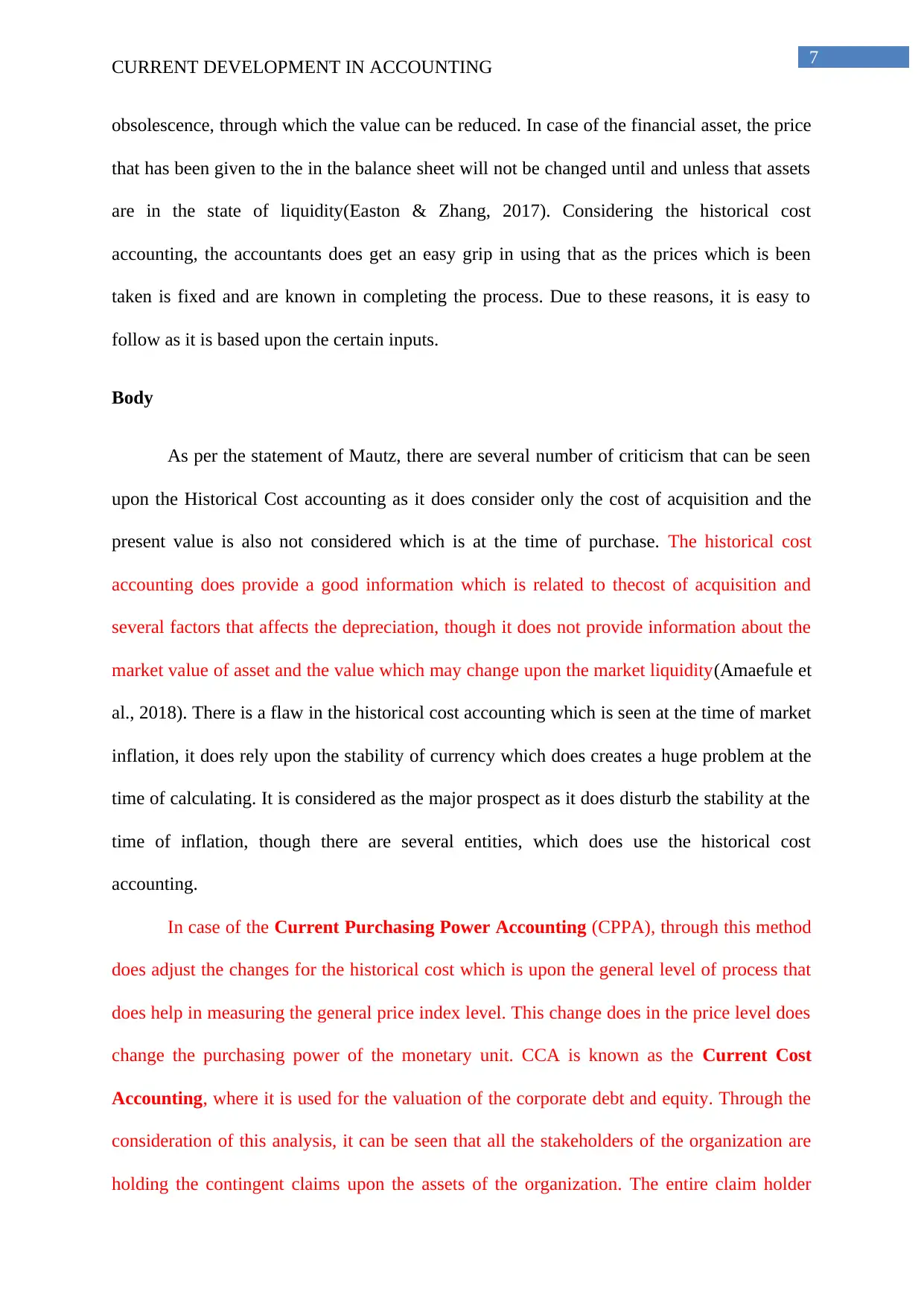
7
CURRENT DEVELOPMENT IN ACCOUNTING
obsolescence, through which the value can be reduced. In case of the financial asset, the price
that has been given to the in the balance sheet will not be changed until and unless that assets
are in the state of liquidity(Easton & Zhang, 2017). Considering the historical cost
accounting, the accountants does get an easy grip in using that as the prices which is been
taken is fixed and are known in completing the process. Due to these reasons, it is easy to
follow as it is based upon the certain inputs.
Body
As per the statement of Mautz, there are several number of criticism that can be seen
upon the Historical Cost accounting as it does consider only the cost of acquisition and the
present value is also not considered which is at the time of purchase. The historical cost
accounting does provide a good information which is related to thecost of acquisition and
several factors that affects the depreciation, though it does not provide information about the
market value of asset and the value which may change upon the market liquidity(Amaefule et
al., 2018). There is a flaw in the historical cost accounting which is seen at the time of market
inflation, it does rely upon the stability of currency which does creates a huge problem at the
time of calculating. It is considered as the major prospect as it does disturb the stability at the
time of inflation, though there are several entities, which does use the historical cost
accounting.
In case of the Current Purchasing Power Accounting (CPPA), through this method
does adjust the changes for the historical cost which is upon the general level of process that
does help in measuring the general price index level. This change does in the price level does
change the purchasing power of the monetary unit. CCA is known as the Current Cost
Accounting, where it is used for the valuation of the corporate debt and equity. Through the
consideration of this analysis, it can be seen that all the stakeholders of the organization are
holding the contingent claims upon the assets of the organization. The entire claim holder
CURRENT DEVELOPMENT IN ACCOUNTING
obsolescence, through which the value can be reduced. In case of the financial asset, the price
that has been given to the in the balance sheet will not be changed until and unless that assets
are in the state of liquidity(Easton & Zhang, 2017). Considering the historical cost
accounting, the accountants does get an easy grip in using that as the prices which is been
taken is fixed and are known in completing the process. Due to these reasons, it is easy to
follow as it is based upon the certain inputs.
Body
As per the statement of Mautz, there are several number of criticism that can be seen
upon the Historical Cost accounting as it does consider only the cost of acquisition and the
present value is also not considered which is at the time of purchase. The historical cost
accounting does provide a good information which is related to thecost of acquisition and
several factors that affects the depreciation, though it does not provide information about the
market value of asset and the value which may change upon the market liquidity(Amaefule et
al., 2018). There is a flaw in the historical cost accounting which is seen at the time of market
inflation, it does rely upon the stability of currency which does creates a huge problem at the
time of calculating. It is considered as the major prospect as it does disturb the stability at the
time of inflation, though there are several entities, which does use the historical cost
accounting.
In case of the Current Purchasing Power Accounting (CPPA), through this method
does adjust the changes for the historical cost which is upon the general level of process that
does help in measuring the general price index level. This change does in the price level does
change the purchasing power of the monetary unit. CCA is known as the Current Cost
Accounting, where it is used for the valuation of the corporate debt and equity. Through the
consideration of this analysis, it can be seen that all the stakeholders of the organization are
holding the contingent claims upon the assets of the organization. The entire claim holder
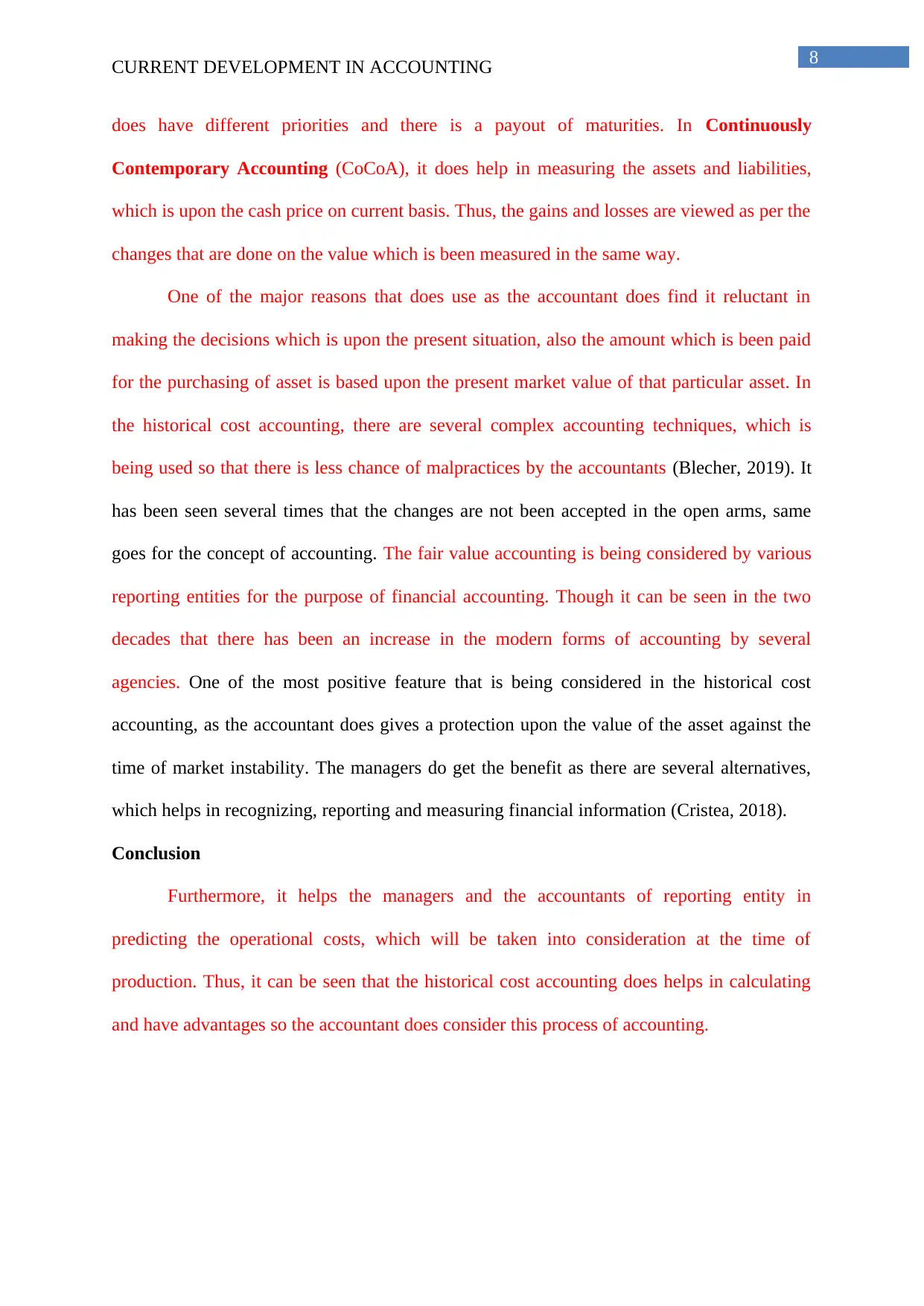
8
CURRENT DEVELOPMENT IN ACCOUNTING
does have different priorities and there is a payout of maturities. In Continuously
Contemporary Accounting (CoCoA), it does help in measuring the assets and liabilities,
which is upon the cash price on current basis. Thus, the gains and losses are viewed as per the
changes that are done on the value which is been measured in the same way.
One of the major reasons that does use as the accountant does find it reluctant in
making the decisions which is upon the present situation, also the amount which is been paid
for the purchasing of asset is based upon the present market value of that particular asset. In
the historical cost accounting, there are several complex accounting techniques, which is
being used so that there is less chance of malpractices by the accountants (Blecher, 2019). It
has been seen several times that the changes are not been accepted in the open arms, same
goes for the concept of accounting. The fair value accounting is being considered by various
reporting entities for the purpose of financial accounting. Though it can be seen in the two
decades that there has been an increase in the modern forms of accounting by several
agencies. One of the most positive feature that is being considered in the historical cost
accounting, as the accountant does gives a protection upon the value of the asset against the
time of market instability. The managers do get the benefit as there are several alternatives,
which helps in recognizing, reporting and measuring financial information (Cristea, 2018).
Conclusion
Furthermore, it helps the managers and the accountants of reporting entity in
predicting the operational costs, which will be taken into consideration at the time of
production. Thus, it can be seen that the historical cost accounting does helps in calculating
and have advantages so the accountant does consider this process of accounting.
CURRENT DEVELOPMENT IN ACCOUNTING
does have different priorities and there is a payout of maturities. In Continuously
Contemporary Accounting (CoCoA), it does help in measuring the assets and liabilities,
which is upon the cash price on current basis. Thus, the gains and losses are viewed as per the
changes that are done on the value which is been measured in the same way.
One of the major reasons that does use as the accountant does find it reluctant in
making the decisions which is upon the present situation, also the amount which is been paid
for the purchasing of asset is based upon the present market value of that particular asset. In
the historical cost accounting, there are several complex accounting techniques, which is
being used so that there is less chance of malpractices by the accountants (Blecher, 2019). It
has been seen several times that the changes are not been accepted in the open arms, same
goes for the concept of accounting. The fair value accounting is being considered by various
reporting entities for the purpose of financial accounting. Though it can be seen in the two
decades that there has been an increase in the modern forms of accounting by several
agencies. One of the most positive feature that is being considered in the historical cost
accounting, as the accountant does gives a protection upon the value of the asset against the
time of market instability. The managers do get the benefit as there are several alternatives,
which helps in recognizing, reporting and measuring financial information (Cristea, 2018).
Conclusion
Furthermore, it helps the managers and the accountants of reporting entity in
predicting the operational costs, which will be taken into consideration at the time of
production. Thus, it can be seen that the historical cost accounting does helps in calculating
and have advantages so the accountant does consider this process of accounting.
⊘ This is a preview!⊘
Do you want full access?
Subscribe today to unlock all pages.

Trusted by 1+ million students worldwide
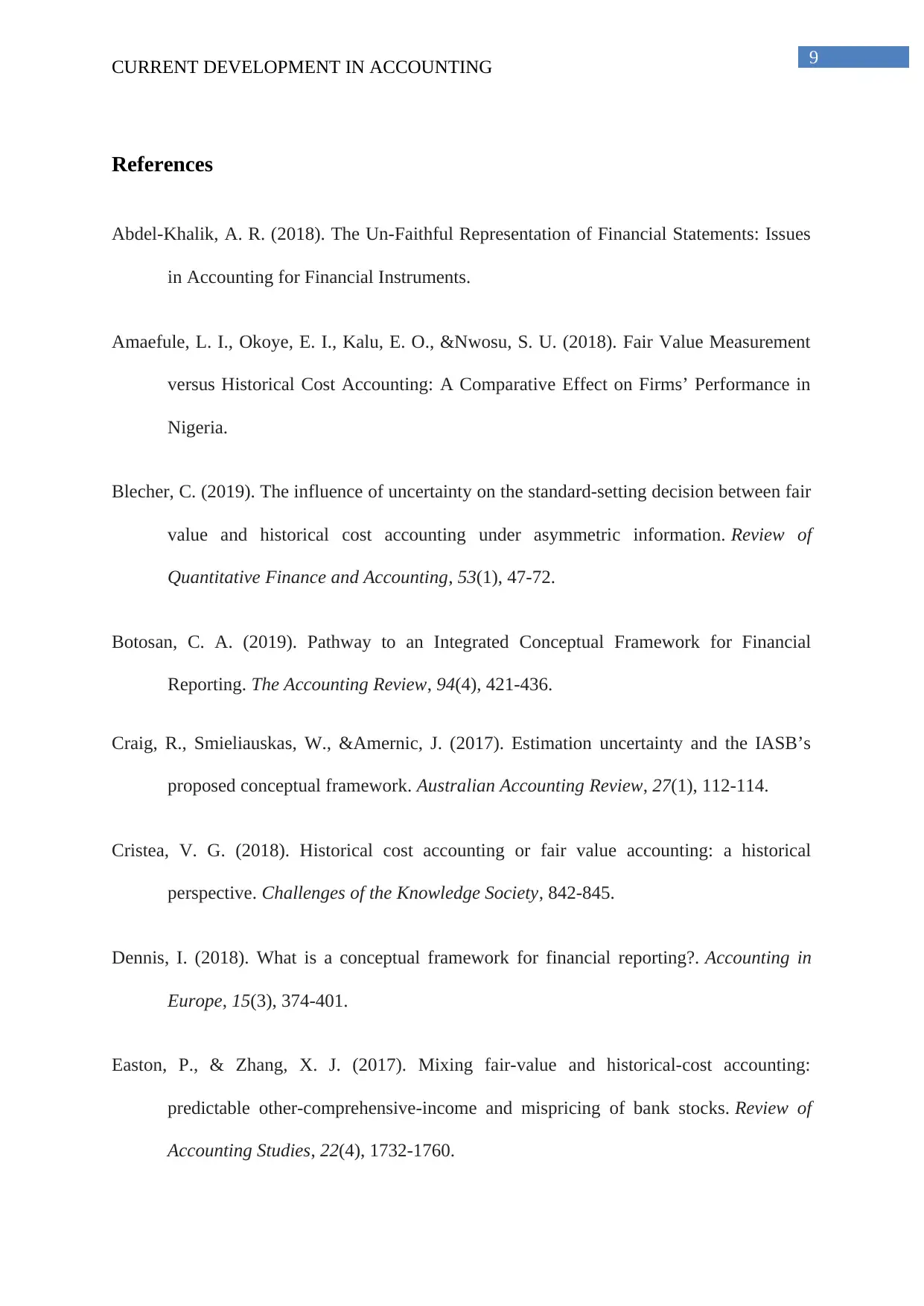
9
CURRENT DEVELOPMENT IN ACCOUNTING
References
Abdel-Khalik, A. R. (2018). The Un-Faithful Representation of Financial Statements: Issues
in Accounting for Financial Instruments.
Amaefule, L. I., Okoye, E. I., Kalu, E. O., &Nwosu, S. U. (2018). Fair Value Measurement
versus Historical Cost Accounting: A Comparative Effect on Firms’ Performance in
Nigeria.
Blecher, C. (2019). The influence of uncertainty on the standard-setting decision between fair
value and historical cost accounting under asymmetric information. Review of
Quantitative Finance and Accounting, 53(1), 47-72.
Botosan, C. A. (2019). Pathway to an Integrated Conceptual Framework for Financial
Reporting. The Accounting Review, 94(4), 421-436.
Craig, R., Smieliauskas, W., &Amernic, J. (2017). Estimation uncertainty and the IASB’s
proposed conceptual framework. Australian Accounting Review, 27(1), 112-114.
Cristea, V. G. (2018). Historical cost accounting or fair value accounting: a historical
perspective. Challenges of the Knowledge Society, 842-845.
Dennis, I. (2018). What is a conceptual framework for financial reporting?. Accounting in
Europe, 15(3), 374-401.
Easton, P., & Zhang, X. J. (2017). Mixing fair-value and historical-cost accounting:
predictable other-comprehensive-income and mispricing of bank stocks. Review of
Accounting Studies, 22(4), 1732-1760.
CURRENT DEVELOPMENT IN ACCOUNTING
References
Abdel-Khalik, A. R. (2018). The Un-Faithful Representation of Financial Statements: Issues
in Accounting for Financial Instruments.
Amaefule, L. I., Okoye, E. I., Kalu, E. O., &Nwosu, S. U. (2018). Fair Value Measurement
versus Historical Cost Accounting: A Comparative Effect on Firms’ Performance in
Nigeria.
Blecher, C. (2019). The influence of uncertainty on the standard-setting decision between fair
value and historical cost accounting under asymmetric information. Review of
Quantitative Finance and Accounting, 53(1), 47-72.
Botosan, C. A. (2019). Pathway to an Integrated Conceptual Framework for Financial
Reporting. The Accounting Review, 94(4), 421-436.
Craig, R., Smieliauskas, W., &Amernic, J. (2017). Estimation uncertainty and the IASB’s
proposed conceptual framework. Australian Accounting Review, 27(1), 112-114.
Cristea, V. G. (2018). Historical cost accounting or fair value accounting: a historical
perspective. Challenges of the Knowledge Society, 842-845.
Dennis, I. (2018). What is a conceptual framework for financial reporting?. Accounting in
Europe, 15(3), 374-401.
Easton, P., & Zhang, X. J. (2017). Mixing fair-value and historical-cost accounting:
predictable other-comprehensive-income and mispricing of bank stocks. Review of
Accounting Studies, 22(4), 1732-1760.
Paraphrase This Document
Need a fresh take? Get an instant paraphrase of this document with our AI Paraphraser
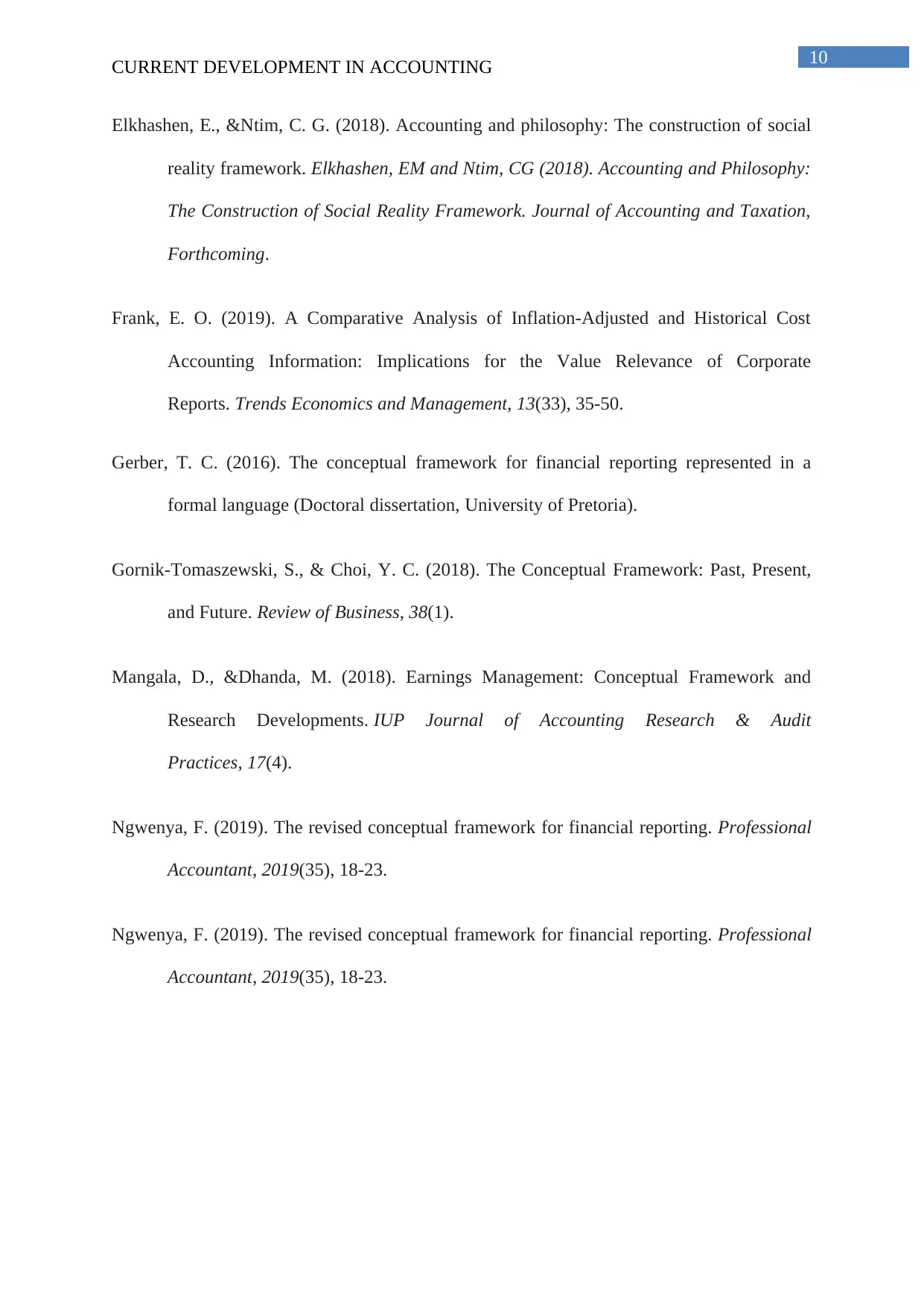
10
CURRENT DEVELOPMENT IN ACCOUNTING
Elkhashen, E., &Ntim, C. G. (2018). Accounting and philosophy: The construction of social
reality framework. Elkhashen, EM and Ntim, CG (2018). Accounting and Philosophy:
The Construction of Social Reality Framework. Journal of Accounting and Taxation,
Forthcoming.
Frank, E. O. (2019). A Comparative Analysis of Inflation-Adjusted and Historical Cost
Accounting Information: Implications for the Value Relevance of Corporate
Reports. Trends Economics and Management, 13(33), 35-50.
Gerber, T. C. (2016). The conceptual framework for financial reporting represented in a
formal language (Doctoral dissertation, University of Pretoria).
Gornik-Tomaszewski, S., & Choi, Y. C. (2018). The Conceptual Framework: Past, Present,
and Future. Review of Business, 38(1).
Mangala, D., &Dhanda, M. (2018). Earnings Management: Conceptual Framework and
Research Developments. IUP Journal of Accounting Research & Audit
Practices, 17(4).
Ngwenya, F. (2019). The revised conceptual framework for financial reporting. Professional
Accountant, 2019(35), 18-23.
Ngwenya, F. (2019). The revised conceptual framework for financial reporting. Professional
Accountant, 2019(35), 18-23.
CURRENT DEVELOPMENT IN ACCOUNTING
Elkhashen, E., &Ntim, C. G. (2018). Accounting and philosophy: The construction of social
reality framework. Elkhashen, EM and Ntim, CG (2018). Accounting and Philosophy:
The Construction of Social Reality Framework. Journal of Accounting and Taxation,
Forthcoming.
Frank, E. O. (2019). A Comparative Analysis of Inflation-Adjusted and Historical Cost
Accounting Information: Implications for the Value Relevance of Corporate
Reports. Trends Economics and Management, 13(33), 35-50.
Gerber, T. C. (2016). The conceptual framework for financial reporting represented in a
formal language (Doctoral dissertation, University of Pretoria).
Gornik-Tomaszewski, S., & Choi, Y. C. (2018). The Conceptual Framework: Past, Present,
and Future. Review of Business, 38(1).
Mangala, D., &Dhanda, M. (2018). Earnings Management: Conceptual Framework and
Research Developments. IUP Journal of Accounting Research & Audit
Practices, 17(4).
Ngwenya, F. (2019). The revised conceptual framework for financial reporting. Professional
Accountant, 2019(35), 18-23.
Ngwenya, F. (2019). The revised conceptual framework for financial reporting. Professional
Accountant, 2019(35), 18-23.
1 out of 11
Related Documents
Your All-in-One AI-Powered Toolkit for Academic Success.
+13062052269
info@desklib.com
Available 24*7 on WhatsApp / Email
![[object Object]](/_next/static/media/star-bottom.7253800d.svg)
Unlock your academic potential
Copyright © 2020–2025 A2Z Services. All Rights Reserved. Developed and managed by ZUCOL.





